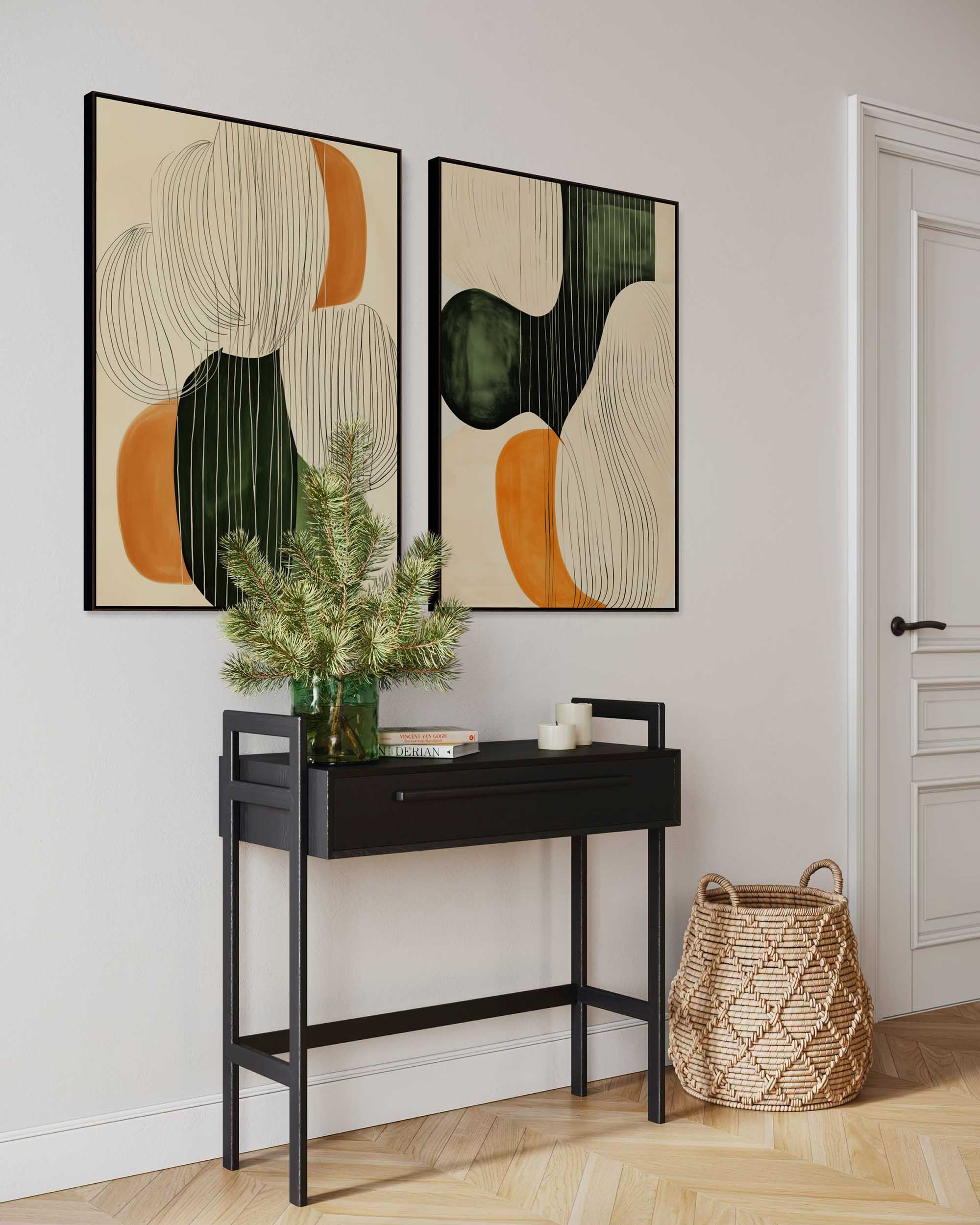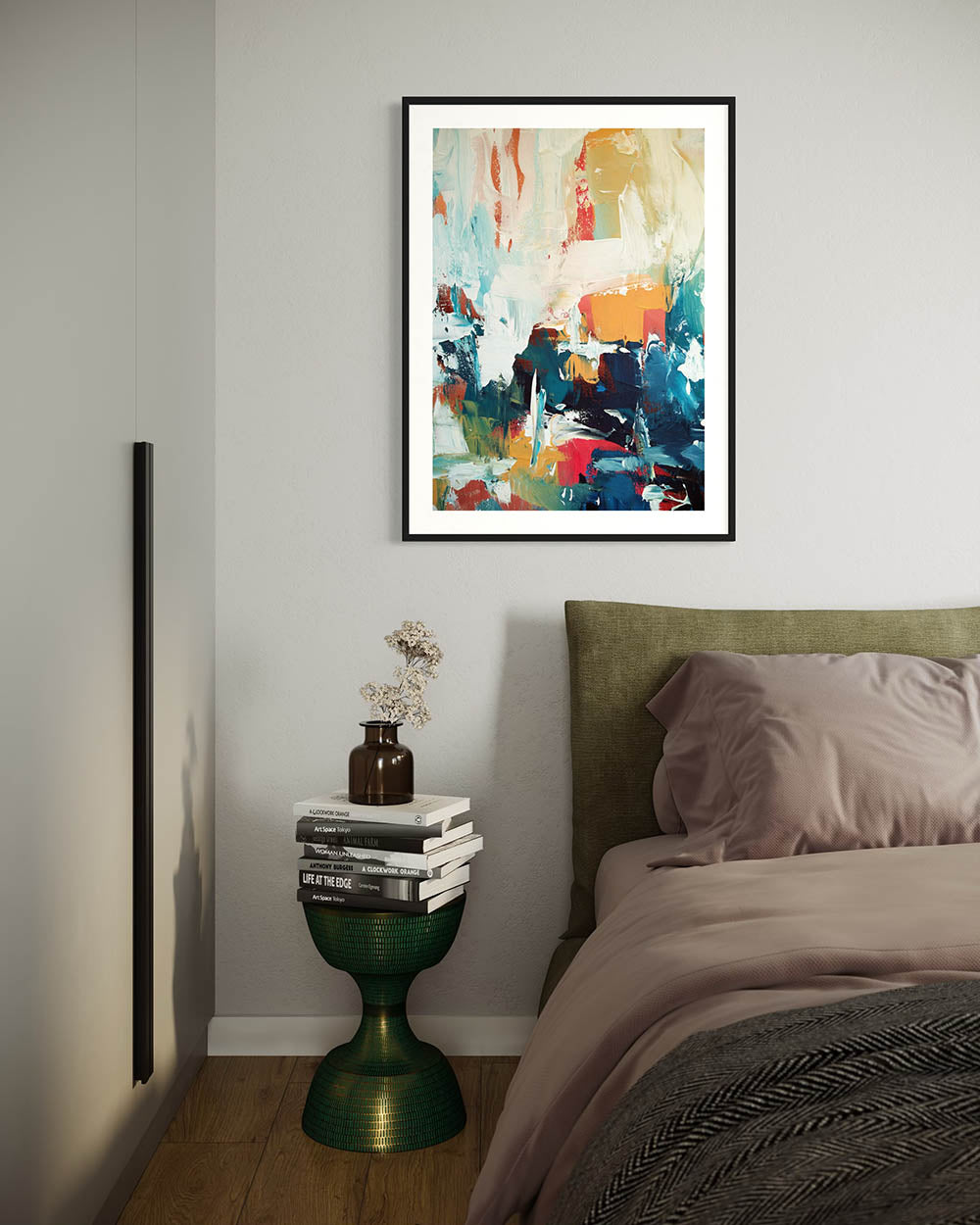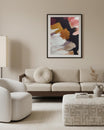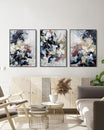
Abstract art emerged in Europe during the late 19th and early 20th century, at a time when the world was on the cusp of great change due to advancements in science, philosophy and art. The early pioneers of this exciting modern art movement were Kandinsky, Mondrian and Picasso amongst others.
It’s difficult to define abstract art, but the word ‘Abstract’ means to exist as an idea, feeling or quality, not materially as an object. Abstract art is non-objective, non-representational - a medium in which the visible world plays little or no part.
It’s a visual language of its own – a genre where lines are melded with shapes, bold colours and forms to create works that allow audiences to make their own assumptions as to the meaning. In other words, abstract art shows the viewer, it doesn’t tell, which is what makes it popular to this day – it can be personalised to the individual based on their own perspective.
Although the earliest known definitive abstract art painting was painted by Wassily Kandinsky around 1910-1911, the roots of abstract art date back much further, to ancient Egypt, Mesopotamia and Asia.
The Modern Masters
Prior to the emergence of abstract art, painters were moving away from the more traditional genres of Romanticism and Realism of the early 1800s into Impressionism and Post-Impressionism later in the century - a new concept that used small, thin brush strokes, with an emphasis on changing light and blending colours.
Pablo Picasso

Guernica – Pablo Picasso – Credit: Artst.org
Malaga-born Pablo Picasso’s work has encompassed just about every experimental art genre that ever existed. A pioneer of Cubism, Classicism and Surrealism - much of his work incorporates the abstract, allowing the viewer to interpret his art in their own way.
When he was 23 years old, Picasso moved from Spain to Paris, the centre of the avant-garde lifestyle, and befriended writers, artists and collectors who were encouraging of his work. The experience greatly influenced his paintings. It was in Paris that he created ‘Ma Jolie’ in 1911, a breath-taking combination of cubism and abstract art in dark hues said to depict his girlfriend and muse at the time.
Wassily Kandinsky

Wassily Kandinsky – Angel of the Last Judgement Credit: WikiArt
Although Russian painter and theorist Wassily Kandinsky is one of the pioneers of abstract art, he began his storied career in law and teaching and didn’t begin to draw or paint until he was 30 years old.
The self-taught artist gained insight from studying the works of Monet and Wagner and in 1896, he ventured to Munich where he began to paint his early abstract pieces. During his ‘Blue Rider Period’ from 1911 to 1914, he curated some of his best works including his ‘Untitled First Abstract Watercolour’ in 1910 and ‘Squares with Concentric Circles’ in 1913.
When the news of WWI broke, Kandinsky returned to Moscow, becoming involved in cultural politics, art education and museum reform in the country. He spent time teaching yet found little inspiration in Russia for his art, although it was during this time, he met his wife, Nina.
When the war was over, he returned to Munich to teach at the Bauhaus School of Architecture and painted some of his finest works including ‘On White II’ and ‘Soft Hard’ before relocating to Paris over a decade later, then finally retiring to the Pyrenees.
Throughout his career Solomon Guggenheim championed his artwork and exhibited pieces around the world.
However, when the Spanish Civil War broke out in 1937, his paintings took a more sombre turn. Large statement pieces such as ‘Guernica’ and ‘The Weeping Woman’ were curated in protest of the atrocities that befell the Spanish city, but to the trained eye, they also signified hope with symbolic messages hidden inside the art.
Many of Picasso’s works were hybrid by design, a blend of 2D and 3D techniques and fusions of different genres and it was his ability to foresee future art trends and his fearless experimentation which inspired many artists that followed.
When Cubism arrived in the early 1900s, it was a ground-breaking moment for the art world. The works were fragmented and abstract with deconstructed scenes which were then reassembled with geometric outlines and cubes in unfathomable ways. It was the advent of Cubism that paved the way for abstract art as a singular genre, with Pablo Picasso, Georges Braque et al, leading the charge.
Ancient cultures would use similar art forms to paint inscriptions on rocks, pottery and textiles. There are parallels for example, between the geometric, mathematical patterns of North African Zellij tiles from the 11th century and a Piet Mondrian painting. Jackson Pollock was inspired by Native American art painted centuries before his existence and the swift lines and natural patterns used in early Islamic and Chinese texts can be seen unfolding in the works of Kandinsky and others.
Credit: Wassily Kandinsky – Angel of the Last Judgement - WikiArt
Piet Mondrian

Tableau No. IV Lozenge Composition with Red, Grey, Blue, Yellow and Black. Credit: piet-mondrian.org
Dutch painter Piet Mondrian is known for founding the ‘De Stijl’ with Theo van Doesburg - an art movement in the Netherlands that focused on abstract works. The movement considered the aesthetic principles of sculpture, architecture and graphic design to create new styles of artwork.
Mondrian argued that the drawn lines of draughtsmanship were at the heart of painting for every artist and chose to refine his representations to the vertical and horizontal, the positive and negative and the masculine and feminine, to create a universal, mathematical balance on the canvas.
He worked with a simple palette of colours, painting basic forms - ensuring what transpired was a common visual language that could be understood by all and easily translated, thus, transcending cultures and divisions.
Although Mondrian spent time painting in both the Netherlands and Paris, he didn’t become a household name until he moved to New York during WWII. His first solo exhibit was held in the city, and his works appreciated by citizens of the Big Apple.
Today, his most famous pieces are ‘Broadway Boogie-Woogie’, ‘Tableau No. IV Lozenge Composition with Red, Grey, Blue, Yellow and Black’ and ‘Composition with Large Red Plane, Yellow, Black, Grey and Blue’.
Mark Rothko

Credit: Rothko Chapel Houston, Texas – mark-rothko.org
Markus Rothkowitz, better known as Mark Rothko, was born in Russia in 1903. When he was 10 years old, his family moved to the Portland, Oregon in the United States. He pursued a degree in liberal arts and sciences at Yale, however dropped out of college early. Instead he travelled to New York to take a course in European modernism under the guidance of Professor Max Weber.
His early paintings were influenced by Marc Chagall and were mainly of the Expressionist genre. However, it was during a Brooklyn teaching gig in 1933 that he began to show his true artistic skills and people began to take his work seriously.
Rothko’s art began to feature in Portland’s Museum of Art and New York’s Contemporary Arts Gallery alongside other modern artists known as “The Ten”. During the 1940s in the era of Surrealism in New York, he joined Jackson Pollock and Willem de Kooning who began referring to their work as Abstract Expressionist pieces.
For the next couple of decades he focused on large scale canvasses in his signature style using a technique called ‘Colour Field’ which used bold blocks of colour and simple layering to create a rich depth of field. The colours in his canvases began to glow from within and he earned many lucrative commissions for larger works, some of which are still displayed today.
His best-known abstract paintings include, ‘Orange Red Yellow’ ‘Black on Maroon’, ‘No 1 Royal Red and Blue’ and ‘Red Brown and Black’.
Jackson Pollock

Mural – Jackson Pollock – Credit: Jackson-pollock.org
Jackson Pollock was an influential American artist hailing from Cody, Wyoming. He is famous for his works in the Abstract Expressionist movement. He cites his influences as Native American art he saw as a child and Mexican Surrealist artist Diego Rivera.
In 1939 in New York City Pollock discovered a Picasso exhibition at the Museum of Modern Art, and like Rothko became inspired by European modernism. He realised the expressive power on the canvas and began to forge a brand-new style, now known as his famous ‘drip paintings’. His original series of Abstract Expressionism works altered the course of art in America.
Pollock’s tried and tested method of painting was unusual, laying the canvas on the floor or against a wall and allowing the paint to drip down from the can.
He didn’t use paint brushes, instead opting for sticks and knives to create the lines and undulating patterns his works are known for. It is said that the method was emotive, expressive and mood driven and showcased real-time feelings of the artist as the pieces came to life.
His methods were both praised and ridiculed by art critics of the time and in 1951, he left this style behind to paint in darker colours signifying struggles in his personal life.
Jackson Pollock is, to this day, seen as a leader of the American Abstract movement, with ‘Number One, 1950 Lavender Mist’, ‘Blue Poles’ and ‘Autumn Rhythm’ as some of his most popular pieces.
Abstract Art Exhibitions In London 2022
If you would like to gain artistic inspiration from different genres, just as the modern masters did, the London 2022 Art Exhibitions below shouldn’t be missed.
Exhibit: Surrealism Beyond Borders at the Tate Modern
Dates: 24 February to 29 August 2022.
Link: https://www.tate.org.uk/whats-on/tate-modern/exhibition/surrealism-beyond-borders
Exhibit: Cezanne at Tate Modern
Dates: 6 October 2022 to 12 March 2023
Link: https://www.tate.org.uk/whats-on/tate-modern/exhibition/ey-exhibition-cezanne
Exhibit: Living with Art – UK Touring Exhibition Picasso to Celmins at the British Museum
Dates: Until 24 April 2022
Link: https://www.britishmuseum.org/exhibitions/living-art-picasso-celmins
Exhibit: Picasso at National Gallery
Pablo Picasso’s works can also be seen year-round at the National Gallery:
Link: https://www.nationalgallery.org.uk/artists/pablo-picasso
We hope you enjoyed our discussion on the definition of what is abstract art?
If you'd like to shop original abstract paintings and abstract art prints, discover our collection of affordable, premium quality art here.






















